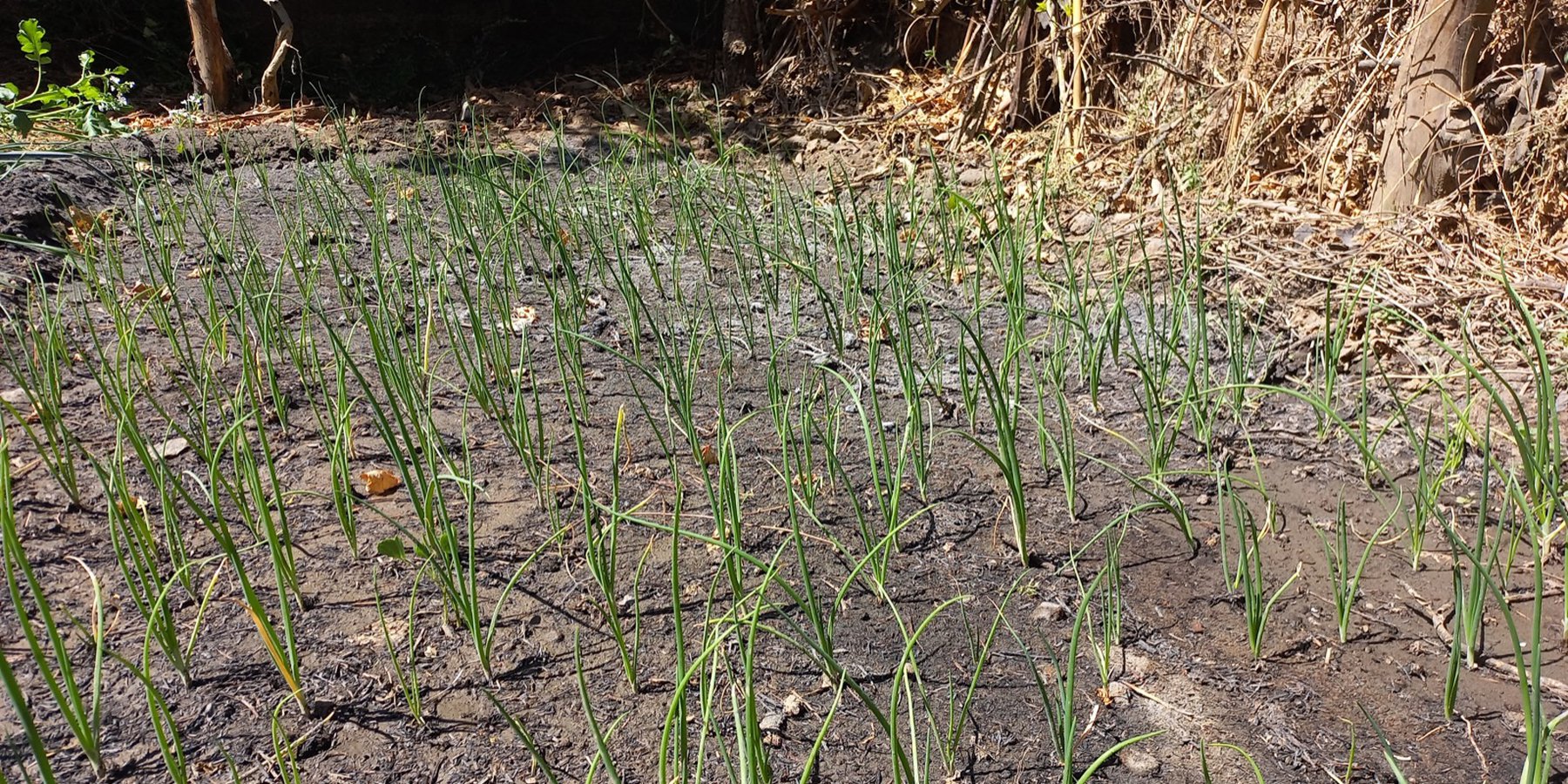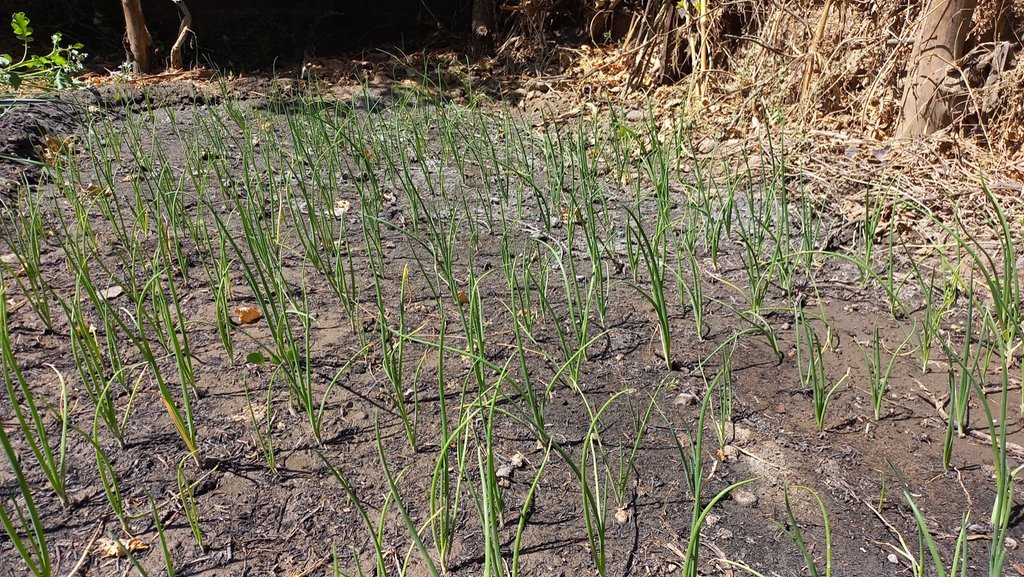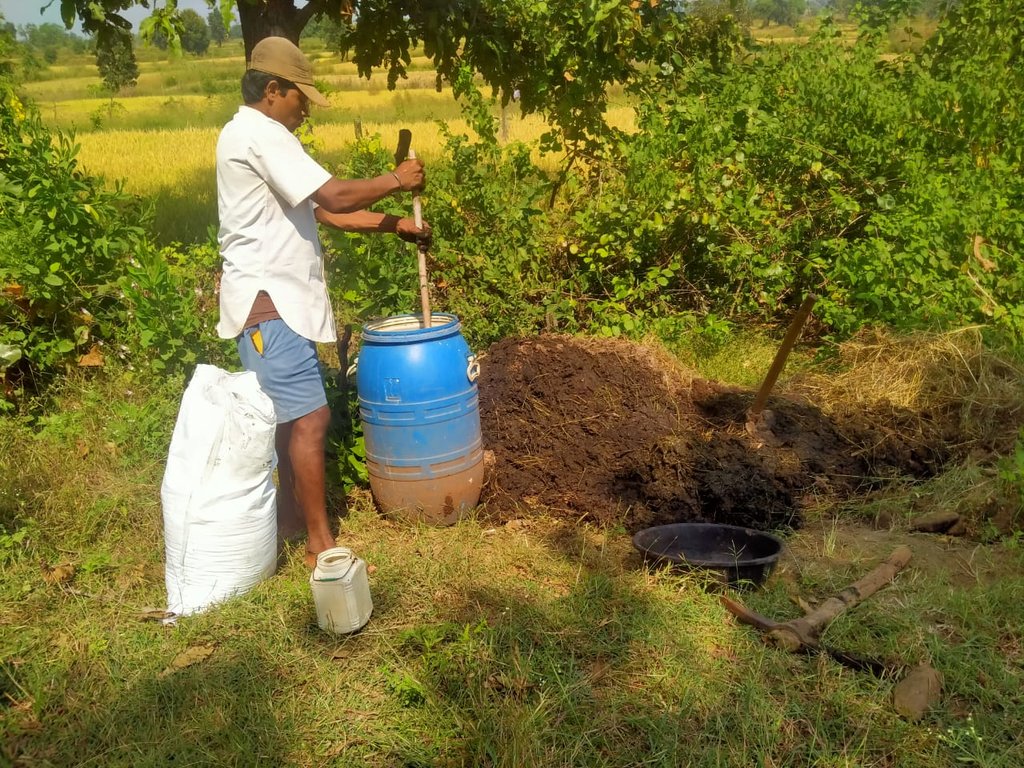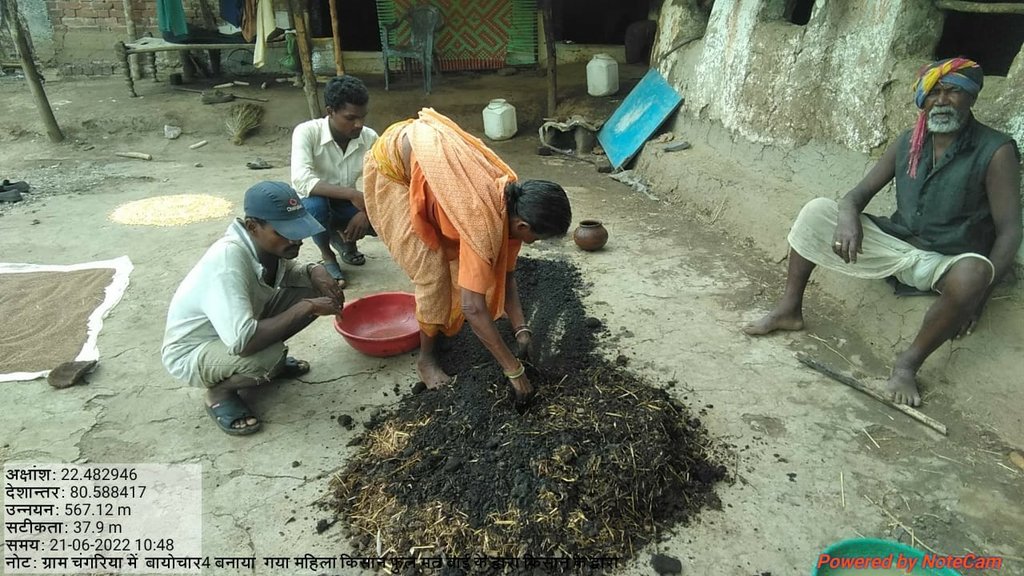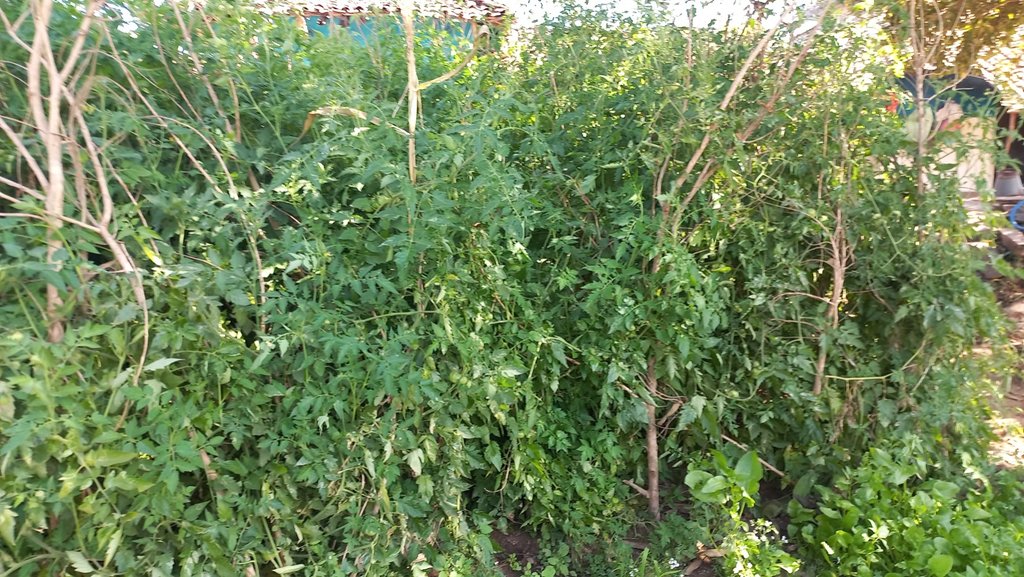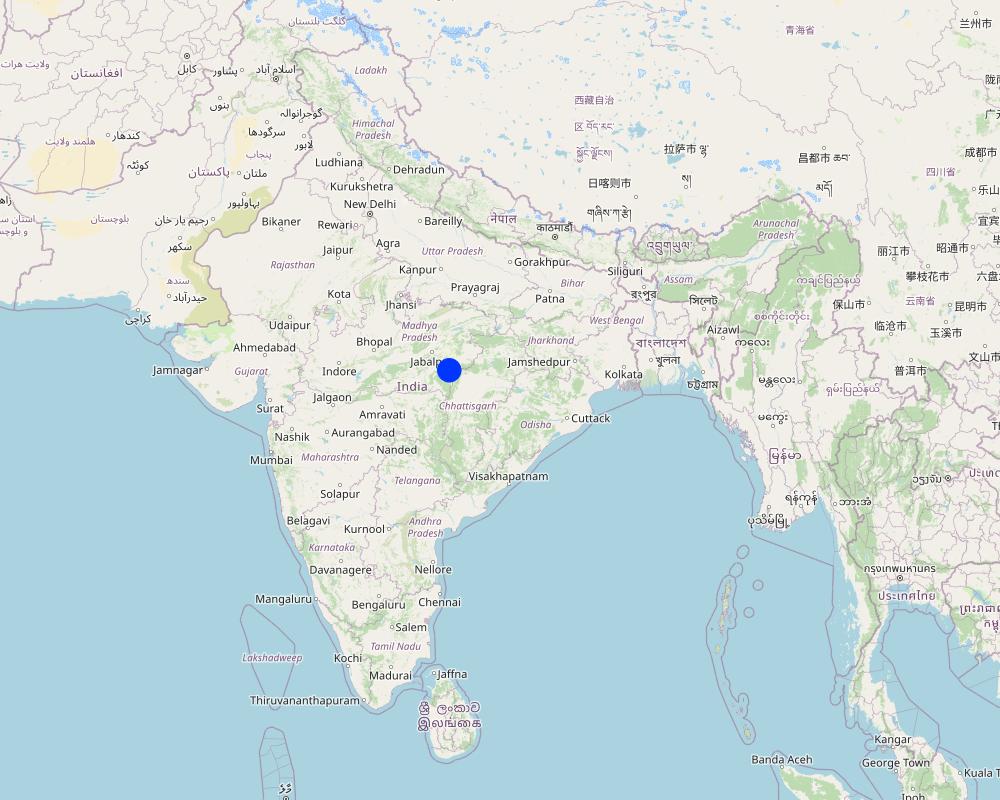Biochar Application on Homestead Land [India]
- Creación:
- Actualización:
- Compilador: Santosh Gupta
- Editores: Noel Templer, Stephanie Katsir, Kim Arora, Tabitha Nekesa, Ahmadou Gaye, Siagbé Golli
- Revisores: Udo Höggel, Sally Bunning
technologies_6693 - India
Visualizar secciones
Expandir todo Colapsar todos1. Información general
1.2 Detalles de contacto de las personas de referencia e instituciones involucradas en la evaluación y la documentación de la Tecnología
Nombre del proyecto que financió la documentación/ evaluación de la Tecnología (si fuera relevante)
Soil protection and rehabilitation for food security (ProSo(i)l)Nombre de la(s) institución(es) que facilitaron la documentación/ evaluación de la Tecnología (si fuera relevante)
GIZ India (GIZ India) - IndiaNombre de la(s) institución(es) que facilitaron la documentación/ evaluación de la Tecnología (si fuera relevante)
Alliance Bioversity and International Center for Tropical Agriculture (Alliance Bioversity-CIAT) - KeniaNombre de la(s) institución(es) que facilitaron la documentación/ evaluación de la Tecnología (si fuera relevante)
Ecociate Consultants (Ecociate Consultants) - India1.3 Condiciones referidas al uso de datos documentados mediante WOCAT
El compilador y la/s persona(s) de referencia claves aceptan las condiciones acerca del uso de los datos documentados mediante WOCAT:
Sí
1.4 Declaración de la sostenibilidad de la Tecnología descrita
¿La Tecnología aquí descrita resulta problemática en relación a la degradación de la tierra, de tal forma que no puede considerársela una tecnología sostenible para el manejo de la tierra?
No
Comentarios:
The technology described here is the application of biochar on homestead land. This technology positively impacts soil health and crop production.
2. Descripción de la Tecnología MST
2.1 Breve descripción de la Tecnología
Definición de la Tecnología:
Biochar is a carbon-rich solid formed from the organic residue by pyrolysis. Biochar is a stable, highly water and nutrient-retentive product that benefits microorganisms and has a very high carbon sequestration potential. Farmers in the project area have applied it to their homesteads or kitchen gardens.
2.2 Descripción detallada de la Tecnología
Descripción:
Biochar, a sustainable soil amendment, is produced through pyrolysis, where organic matter such as wood or agricultural waste is heated in a closed container under low-oxygen conditions. Applying biochar to soil has numerous benefits for improving soil health, such as enhancing soil fertility, reducing greenhouse gas emissions, improving soil microbiology, and reducing soil erosion. One of the most significant benefits of biochar is its ability to sequester atmospheric carbon dioxide into the soil, which can help mitigate climate change by reducing the amount of carbon dioxide in the atmosphere. Biochar can also remove contaminants from soil and water and serve as a compost component.
Biochar also reduces the emission of ammonia and carbon dioxide (Cabeza et al. 2018), lowers soil compactness, optimizes compost (Liang et al. 2010), improves water retention and the sorption of heavy metals, increases the availability of micronutrients for plants and increases the pH of soils (Van Zwieten et al. 2010). Biochar also stimulates the growth of rhizosphere microorganisms and mycorrhizal fungi (Głuszek et al. 2017). These bacteria and fungi may also promote plant growth (Compant et al. 2010). The pH values of biochars are positively correlated with the formation of carbonates and the contents of inorganic alkalis (Ding et al. 2014). The pH value of biochar ranges from 6.5 to 10.8. It is advisable to test the pH values of both soils and biochar to reach at the optimal quantity of biochar to be applied in the field.
In the Mandla district, agriculture is the backbone of the economy, and farmers are constantly adopting new farming technologies to increase their agricultural production. One such technology that has positively impacted more than a thousand farmers in the region is the application of biochar in homestead land under a GIZ-funded Soil protection and rehabilitation of degraded soil for food security in India (ProSoil) program. Biochar in this region is prepared using low cost Biochar Kiln units developed by Indian council of agriculture research institutions, traditional methods, such as digging soil pits and burning organic residue while covering its top with soil. Since the Mandla district is a high-rainfall region, most farmers broadcast biochar over their fields before growing rabi (winter) crops. Commonly grown rabi crops in this region are mustard, vegetables, and maize.
Farmers in the Mandla district use small units of biochar production. The recovery rate of biochar is 20%, with a capacity of 100kg of organic material. The application rate per unit area varies from farmer to farmer.
1. Landholding: Farmers with more extensive land holdings or generally rotationally applied biochar in the parcels.
2. The intervention of biochar application was introduced in this region in 2020. The new practice is evolving, and the application rate of biochar varies from farmer to farmer depending on the availability of raw materials and labour availability (family/hired)
The most suitable biochar application rate is 10 − 20 t/ha. Moreover, it is essential to consider the compatibility and complementarity between biochar, soil texture, and management factors such as Nitrogen (N) application rate, pH values and growing environment into consideration (Yang Gao et al., 2021). More scientific studies are needed to define the quantity of biochar needed based on the local soil conditions. However, the current quantity of applications is very low compared to suggested in secondary documents.
The immediate effects of biochar application on crop production have been significant, with farmers reporting an increase in crop yield by 20-25% across most crops. Simple indicators such as increased grain weight and improved grain quality imply that the crop produced is of higher quality. Another critical benefit highlighted by farmers of biochar application is the retention of soil moisture over a longer duration compared to non-treated fields. Biochar can help the farmers of the Mandla district increase their agricultural productivity while promoting sustainable land use practices.
2.3 Fotografías de la Tecnología
Comentarios generales sobre las fotos:
All the photos have been taken with the consent of participants
2.5 País/ región/ lugares donde la Tecnología fue aplicada y que se hallan comprendidos por esta evaluación
País:
India
Región/ Estado/ Provincia:
Madhya Pradesh
Especifique más el lugar :
Mandla
Especifique la difusión de la Tecnología:
- aplicada en puntos específicos/ concentrada en un área pequeña
¿El/los sitio(s) de la Tecnología se ubica(n) en un área de protección permanente?
No
Comentarios:
Field visits in Gabri and Changariya villages of Bichhhiya block were conducted to understand the technology
Map
×2.6 Fecha de la implementación
Indique año de implementación:
2020
2.7 Introducción de la Tecnología
Especifique cómo se introdujo la Tecnología:
- durante experimentos/ investigación
- mediante proyectos/ intervenciones externas
Comentarios (tipo de proyecto, etc.):
The application of biochar for improving soil health and crop production was introduced in this region through the GIZ-funded program
3. Clasificación de la Tecnología MST
3.1 Propósito(s) principal(es) de la Tecnología MST
- mejorar la producción
- reducir, prevenir, restaurar la degradación de la tierra
- conservar el ecosistema
- mitigar cambio climático y sus impactos
- crear impacto económico benéfico
3.2 Tipo(s) actuales de uso de la tierra donde se aplica la Tecnología
Mezcla de tipos de uso de tierras dentro de la misma unidad de tierras: :
Sí
Especifique el uso combinado de tierras (cultivos/ pastoreo/ árboles):
- Agroforestería

Tierras cultivadas
- Cosecha anual
Cosechas anuales - Especifique cultivos:
- cereales - maíz
- cereales - mijo
- cereales - arroz (humedal)
- cereales - sorgo
- legumes and pulses - lentils
- Mustard
Número de temporadas de cultivo por año:
- 2
Especifique:
Mandla district is predominantly a rainfed region. Homestead land generally has some irrigation facilities available for Kharif (summer) and Rabi (winter) crops.
¿Se practica el intercultivo?
No
¿Se practica la rotación de cultivos?
Sí
Si fuera el caso, especifique :
Vegetable crops such as leafy vegetables, tomatoes, onions, tuber crops, mustard, and maize are commonly grown by farmers. The primary purpose of growing crops on homestead land is to fulfill household-level nutritional requirements.
Comentarios:
As per the district census handbook of Mandla District 2001, the land use pattern of Mandla District is: 61% - under forest area, 21% - cropped area, 5% - not available for cultivation, 7% - under fallow land, and 2% - cultivable area. The net area irrigated is 7% of the net area sown, which has hardly increased in recent times (~9%).
3.3 ¿Cambió el uso de tierras debido a la implementación de la Tecnología?
¿Cambió el uso de tierras debido a la implementación de la Tecnología?
- No (Continúe con la pregunta 3.4)
Comentarios:
There has been no change in land use pattern due to project interventions.
3.4 Provisión de agua
Provisión de agua para la tierra donde se aplica la Tecnología:
- mixta de secano – irrigada
Comentarios:
Mandla has nearly 9% of its net sown area irrigated. The homestead land, where biochar is applied during the rabi season, has some irrigation from surface- or groundwater sources.
3.5 Grupo MST al que pertenece la Tecnología
- agroforestería
- cobertura de suelo/ vegetal mejorada
- manejo integrado de la fertilidad del suelo
3.6 Medidas MST que componen la Tecnología

medidas agronómicas
- A1: vegetación/ cubierta del suelo
- A2: materia orgánica/ fertilidad del suelo

medidas de manejo
- M2: Cambio de gestión/ nivel de intensidad
Comentarios:
The application of biochar in the field has improved the water-holding capacity of the soil along with enhanced microbial activities. This has resulted in better and long-duration vegetation as farmers are in position to cultivate vegetables throughout the year.
3.7 Principales tipos de degradación de la tierra encarados con la Tecnología

erosión de suelos por agua
- Wt: pérdida de capa arable/ erosión de la superficie

deterioro químico del suelo
- Cp: contaminación del suelo

deterioro físico del suelo
- Pc: compactación
- Pu: pérdida de la función bioproductiva a causa de otras actividades

degradación biológica
- Bc: reducción de la cobertura vegetal del suelo
- Bl: pérdida de la vida del suelo
Comentarios:
Biochar acts as soil amendment which helps in improving soil health and status of nutrients in the soil. Some studies have also suggested increase in soil organic carbon as a result of biochar application. Farmers in the project area were also advised to reduce the tillage practices to minimise the soil disturbance.
3.8 Prevención, reducción o restauración de la degradación de la tierra
Especifique la meta de la Tecnología con relación a la degradación de la tierra:
- prevenir la degradación de la tierra
- reducir la degradación de la tierra
Comentarios:
Prior to the application of biochar, farmers were applying synthetic fertilisers and pesticide which was degrading the land. The replacement of synthetic fertilisers with Biochar (also FYM and cow urine mixed with it) has prevented further soil degradation.
4. Especificaciones técnicas, actividades de implementación, insumos y costos
4.1 Dibujo técnico de la Tecnología
Especificaciones técnicas (relacionadas al dibujo técnico):
The drawing presented here is of a biochar kiln unit being developed by the Central Research Institute for Dryland Agriculture (CRIDA) in India for Biochar preparation. A similar unit was used by the land users in the project area. There were some farmers who also did some modifications to make it friendly for the local context. More details about this unit can be obtained from the following sources.
http://www.nicra-icar.in/nicrarevised/images/Books/Biochor%20Bulletin.pdf
http://icar-crida.res.in/Pubs/Biochar%20Research%20Bulletin%20March%202018.pdf (for a description of the HOW to make biochar)
Autor:
Central Research Institute for Dryland Agriculture (CRIDA)
4.2 Información general sobre el cálculo de insumos y costos
Especifique cómo se calcularon los costos e insumos:
- por área de Tecnología
Indique tamaño y unidad de área:
1 Ha
otra / moneda nacional (especifique):
INR
Si fuera relevante, indique la tasa de cambio de dólares americanos a la moneda local (ej. 1 U$ = 79.9 Reales Brasileros): 1 U$ =:
82,5
Indique el costo promedio del salario de trabajo contratado por día:
204
4.3 Actividades de establecimiento
| Actividad | Momento (estación) | |
|---|---|---|
| 1. | Purchase of Biochar Kiln Unit | Once in 4-5 years |
Comentarios:
Since it's a seasonal activity there are not many activities which can be categorised here.
4.4 Costos e insumos necesarios para el establecimiento
| Especifique insumo | Unidad | Cantidad | Costos por unidad | Costos totales por insumo | % de los costos cubiertos por los usuarios de las tierras | |
|---|---|---|---|---|---|---|
| Equipo | Biochar Kiln unit | Number | 1,0 | 9000,0 | 9000,0 | 10,0 |
| Equipo | Transportation | LS | 1,0 | 2000,0 | 2000,0 | 10,0 |
| Costos totales para establecer la Tecnología | 11000,0 | |||||
| Costos totales para establecer la Tecnología en USD | 133,33 | |||||
Si el usuario de la tierra no cubrió el 100% de los costos, indique quién financió el resto del costo:
Project has financially supported the local environment committes in purchase and setting up of the Biochar Kiln units
Comentarios:
Biochar is prepared by a low-cost method:
1. Using Soil pit kiln - Human Labor cost is usually applied as no capital cost is involved in this method.
2. Using Portable Kiln - Its cost generally range from 12000 -14000 Rs if purchased from the ICAR institutions and their associated fabricators. Sometimes farmers also get it made from the local fabricators which cost Rs 4000-6000
Refer to the following Study: Biochar production from Lantana camara (invasive species);-
https://qcat.wocat.net/en/wocat/technologies/view/technologies_6690/
4.5 Actividades de establecimiento/ recurrentes
| Actividad | Momento/ frequencia | |
|---|---|---|
| 1. | Preparation of Biochar using the Lantana Camara | After the monsoon season (September) |
| 2. | Preparing the biochar for application by mixing it with cow dung and cow urine | During Rabi Season (Oct-Nov) |
| 3. | Application of Biochar in homestead land | During Rabi Season (Oct-Nov) |
Comentarios:
A low-cost method of biochar preparation (traditional soil pit or portable kiln method) is used for biochar preparation. Due to simplicity in design, barely any cost is involved in the maintenance of the unit.
4.6 Costos e insumos necesarios para actividades de mantenimiento/ recurrentes (por año)
| Especifique insumo | Unidad | Cantidad | Costos por unidad | Costos totales por insumo | % de los costos cubiertos por los usuarios de las tierras | |
|---|---|---|---|---|---|---|
| Mano de obra | Transportation of biomass and its drying before biochar production | Person-day | 2,0 | 200,0 | 400,0 | 100,0 |
| Mano de obra | Preparation of Biochar by family members | Person-day | 2,0 | 200,0 | 400,0 | 100,0 |
| Mano de obra | Mixing biochar with cow dung and cow urine and making it ready for the application | Person-day | 1,0 | 200,0 | 200,0 | 100,0 |
| Mano de obra | Biochar Application | Person-day | 1,0 | 200,0 | 200,0 | 100,0 |
| Fertilizantes y biocidas | Biomass for Biochar production (Approximate) | 1,0 | 500,0 | 500,0 | 100,0 | |
| Fertilizantes y biocidas | Cow dung | kg | 20,0 | 5,0 | 100,0 | 100,0 |
| Fertilizantes y biocidas | Cow urine | kg | 20,0 | 5,0 | 100,0 | 100,0 |
| Indique los costos totales para mantenecer la Tecnología | 1900,0 | |||||
| Costos totales para mantener la Tecnología en USD | 23,03 | |||||
Comentarios:
A majority of the cost mentioned here is an opportunity cost for the farmers as they do manage all these expenses internally with available family labour and input materials such as cow dung, cow urine biomass etc.
4.7 Factores más determinantes que afectan los costos:
Describa los factores más determinantes que afectan los costos:
The primary factor affecting the cost is the labor cost for applying biochar to the field and the easy availability of biomass/crop residues/Lantana for biochar production
5. Entorno natural y humano
5.1 Clima
Lluvia anual
- < 250 mm
- 251-500 mm
- 501-750 mm
- 751-1,000 mm
- 1,001-1,500 mm
- 1,501-2,000 mm
- 2,001-3,000 mm
- 3,001-4,000 mm
- > 4,000 mm
Especifique el promedio anual de lluvia (si lo conoce), en mm:
1427,70
Especificaciones/ comentarios sobre la cantidad de lluvia:
Monsoon season is June-September which has the majority of the rainfall
Indique el nombre de la estación metereológica de referencia considerada:
District at glance report of Ministry of Water Resources, Central Groundwater Board, North Central Region BHOPAL, 2013
Zona agroclimática
- Sub-húmeda
- semi-árida
The National Bureau of Soil Survey & Land Use Planning (NBSS&LUP) developed twenty agroecological zones based on the growing period as an integrated criterion of adequate rainfall and soil groups. It delineated boundaries adjusted to district boundaries with a minimal number of regions. Mandla District of Madhya Pradesh lies in a hot sub-humid ecoregion with red and black soil. The length of the growing period varies from block to block based on the availability of irrigation with farmers. Thus both sub-humid and semi-arid agroclimatic zones are being considered for the District.
Precipitation: 1000–1500 mm; Potential Evapotranspiration: 1300–1500 mm; Length of Growing Period: 150–180 days
5.2 Topografía
Pendientes en promedio:
- plana (0-2 %)
- ligera (3-5%)
- moderada (6-10%)
- ondulada (11-15%)
- accidentada (16-30%)
- empinada (31-60%)
- muy empinada (>60%)
Formaciones telúricas:
- meseta/ planicies
- cordilleras
- laderas montañosas
- laderas de cerro
- pies de monte
- fondo del valle
Zona altitudinal:
- 0-100 m s.n.m.
- 101-500 m s.n.m.
- 501-1,000 m s.n.m
- 1,001-1,500 m s.n.m
- 1,501-2,000 m s.n.m
- 2,001-2,500 m s.n.m
- 2,501-3,000 m s.n.m
- 3,001-4,000 m s.n.m
- > 4,000 m s.n.m
Indique si la Tecnología se aplica específicamente en:
- no relevante
Comentarios y especificaciones adicionales sobre topografía :
Mandla District is hilly and forested (Satpura hill range) and highly undulating with a narrow strip of cultivated plains in the valley portion of the river and rivulet. The plateau is in the northern part, formed by basalt and east-west trending hills in the southern part. The highest elevation is 934m ASL in the northern region, and the lowest elevation is around 400m ASL.
5.3 Suelos
Profundidad promedio del suelo:
- muy superficial (0-20 cm)
- superficial (21-50 cm)
- moderadamente profunda (51-80 cm)
- profunda (81-120 cm)
- muy profunda (>120 cm)
Textura del suelo (capa arable):
- áspera/ ligera (arenosa)
- mediana (limosa)
Textura del suelo (> 20 cm debajo de la superficie):
- mediana (limosa)
- fina/ pesada (arcilla)
Materia orgánica de capa arable:
- baja (<1%)
Si se halla disponible, adjunte una descripción completa de los suelos o especifique la información disponible, por ej., tipo de suelo, pH/ acidez de suelo, capacidad de intercambio catiónico, nitrógeno, salinidad, etc. :
The soils in the area are generally clayey loam types with sandy loam soil in some areas. In the northern and central parts of the District, the undulating plateau with mounds is covered with slightly deep soil. Regarding the classification of ‘Soils of the World,’ the soils of Mandla are characterized as ‘brown earth.’ These types of soils have developed from granite gneiss and quartzite schist complexes.
5.4 Disponibilidad y calidad de agua
Agua subterránea:
5-50 m
Disponibilidad de aguas superficiales:
mediana
Calidad de agua (sin tratar):
agua potable de mala calidad (requiere tratamiento)
La calidad de agua se refiere a:
agua subterránea y superficial
¿La salinidad del agua es un problema?
No
¿Se está llevando a cabo la inundación del área? :
No
Comentarios y especificaciones adicionales sobre calidad y cantidad de agua:
The pre-monsoon groundwater level in the area ranges from 3 to 14 meters below ground level. (District at Glance, Mandla, Central Ground Water Board, 2013). The locations have a river flowing close to the area; however, access to the surface and sub-surface water is a primary concern. Basaltic lava flows of the Deccan trap underlie the Mandla District. All blocks of the district including project block Bichhiya are categorized as safe blocks. The net groundwater availability in the district is 53779 hectare meters (ham), and the groundwater draft for all uses is 8205 ham, making the Stage of Groundwater Development 15% as a whole for the district. The area's topography, soil, and geology do not let water remain for long durations, causing water scarcity in summer. The irrigation facilities are poor and limited to areas adjoining dams and canals.
5.5 Biodiversidad
Diversidad de especies:
- elevada
Diversidad de hábitats:
- elevada
Comentarios y especificaciones adicionales sobre biodiversidad:
The area is surrounded by the Kanha National Park and Phen Wildlife Sanctuary, with a good presence of forest area. Thus biodiversity is outstanding. Ecological assessment report in Mandla (where this Technology is applied) showed improved biodiversity on common lands under village governance compared to open-access or commons under government ownership. On average, the Shannon diversity index (https://www.statology.org/shannon-diversity-index/) of managed common lands was 1.45 compared to 0.42 for the open access or ungoverned commons. Most of the sites under open access lands are infested by Lantana camara, which is the main reason for the lower biomass and diversity of the ungoverned grounds. More information about the biodiversity in Mandla can be read through the following link.
https://mpsbb.mp.gov.in/completedProject/MB.pdf
5.6 Las características de los usuarios de la tierra que aplican la Tecnología
Sedentario o nómada:
- Sedentario
Orientación del mercado del sistema de producción:
- mixta (subsistencia/ comercial)
Ingresos no agrarios:
- > 50% de todo el ingreso
Nivel relativo de riqueza:
- pobre
- promedio
Individuos o grupos:
- individual/ doméstico
Nivel de mecanización:
- trabajo manual
- tracción animal
Género:
- mujeres
- hombres
Edad de los usuarios de la tierra:
- jóvenes
- personas de mediana edad
Indique otras características relevantes de los usuarios de las tierras:
A large majority of the user belonging to the tribal community, including some households from an ethnic community called Baiga.
5.7 Área promedio de la tierra usada por usuarios de tierra que aplican la Tecnología
- < 0.5 ha
- 0.5-1 ha
- 1-2 ha
- 2-5 ha
- 5-15 ha
- 15-50 ha
- 50-100 ha
- 100-500 ha
- 500-1,000 ha
- 1,000-10,000 ha
- > 10,000 ha
¿Esto se considera de pequeña, mediana o gran escala (refiriéndose al contexto local)?
- pequeña escala
Comentarios:
Around 2000 farmers in different crops have applied the technology
5.8 Tenencia de tierra, uso de tierra y derechos de uso de agua
Tenencia de tierra:
- comunitaria/ aldea
- individual, con título
Derechos de uso de tierra:
- individual
Derechos de uso de agua:
- comunitarios (organizado)
- individual
¿Los derechos del uso de la tierra se basan en un sistema legal tradicional?
Sí
Especifique:
The concerned authorities have issued landowners the land certificates.
5.9 Acceso a servicios e infraestructura
salud:
- pobre
- moderado
- bueno
educación:
- pobre
- moderado
- bueno
asistencia técnica:
- pobre
- moderado
- bueno
empleo (ej. fuera de la granja):
- pobre
- moderado
- bueno
mercados:
- pobre
- moderado
- bueno
energía:
- pobre
- moderado
- bueno
caminos y transporte:
- pobre
- moderado
- bueno
agua potable y saneamiento:
- pobre
- moderado
- bueno
servicios financieros:
- pobre
- moderado
- bueno
Advisory and extension (limited to only project teams):
- pobre
- moderado
- bueno
Comentarios:
Over the years, there has been a development focus from both the Government and other civil society organizations to bring out the facilities at the door of communities, which has improved access of different facilities.
6. Impactos y comentarios para concluir
6.1 Impactos in situ demostrados por la Tecnología
Impactos socioeconómicos
Producción
producción de cultivo
Comentarios/ especifique:
There has not been any systematic impact assessment study to quantify the impact of the intervention. However, in discussions with farmers and implementing agencies during the field visit, an increase of 20-25% in the production of farm products was reported.
calidad de cultivo
Comentarios/ especifique:
Change in crop weight and colour is observed by farmers
manejo de tierras
Comentarios/ especifique:
Improved Soil Health is indicated by farmers based on their observation of improved soil structure, water-holding capacity and soil texture
Ingreso y costos
ingreso agrario
Comentarios/ especifique:
On the account of improved productivity, farmers have reported an increase in their income. However, there has not been any systematic study on the same.
Impactos socioculturales
MST/ conocimiento de la degradación de la tierra
Comentarios/ especifique:
The preparation of biochar from invasive species and its application to soil improved the understanding of farmers on the negative impact of invasive species and advantages of biochar application
Impactos ecológicos
Suelo
humedad del suelo
Comentarios/ especifique:
Soil structure improved by biochar application, improving water holding capacity of soil
pérdida de suelo
Comentarios/ especifique:
Reduction in soil erosion due to improvement in soil structure
compactación de suelo
Comentarios/ especifique:
Reduction in soil compaction due to improvement in soil structure
materia orgánica debajo del suelo C
Comentarios/ especifique:
Based on the observation of farmers and implementing agency, random soil tests of farmers have indicated a slight increase in soil organic carbon
Biodiversidad: vegetación, animales
especies invasoras extrañas
Comentarios/ especifique:
Reduction in invasive alien species named lantana cantara which was uprooted for preparing biochar
Reducción de riesgos de desastres y riesgos climáticos
micro-clima
Comentarios/ especifique:
Improve soil health create an enabling environment for soil micro-organism
Especifique la evaluación de los impactos en el sitio (mediciones):
All the indicated impact measures are based on discussions with farmers, implementing agencies and other stakeholders. These were reported as per their observations, eye estimations and approximation.
6.2 Impactos fuera del sitio demostrados por la Tecnología
Biochar is prepared using invasive species of Lantana Camara. Its eradication from private and commercial land improves the ecosystem.
Especifique la evaluación de los impactos fuera del emplazamiento (medidas):
The scale of implementation is not large enough to have an ecosystem level impact
6.3 Exposición y sensibilidad de la Tecnología al cambio climático gradual y a extremos relacionados al clima/ desastres (desde la percepción de los usuarios de tierras)
Cambio climático gradual
Cambio climático gradual
| Estación | Incremento o reducción | ¿Cómo es que la tecnología soporta esto? | |
|---|---|---|---|
| Otro cambio climático gradual | When biochar is added to soil, it can sequester carbon in the form of stable organic matter, which can remain in the soil for hundreds or even thousands of years. This carbon sequestration can help to reduce the amount of carbon dioxide in the atmosphere, thereby mitigating climate change. | disminuyó | bien |
6.4 Análisis costo-beneficio
¿Cómo se comparan los beneficios con los costos de establecimiento (desde la perspectiva de los usuarios de tierra)?
Ingresos a corto plazo:
positivo
Ingresos a largo plazo:
muy positivo
¿Cómo se comparan los beneficios con los costos de mantenimiento/ recurrentes (desde la perspectiva de los usuarios de tierra)?
Ingresos a corto plazo:
positivo
Ingresos a largo plazo:
muy positivo
Comentarios:
The benefits as indicated above are much higher than the cost involved. More importantly cost is too less as all the resources are being managed internally by the farmers.
6.5 Adopción de la Tecnología
- 1-10%
Si tiene la información disponible, cuantifique (número de hogares y/o área cubierta):
More than 3000 farmers
6.7 Fuerzas/ ventajas/ oportunidades de la Tecnología
| Fuerzas/ ventajas/ oportunidades desde la perspectiva del usuario de la tierra |
|---|
| Increase crop production |
| Improve the quality of farm produce |
| Improve soil water holding capacity |
| Fuerzas/ ventajas/ oportunidades desde la perspectiva del compilador o de otra persona de referencia clave |
|---|
| Improved soil health |
| Mitigate climate change |
| Increase in soil nutrient content |
| Reduction in cost of inputs |
6.8 Debilidades/ desventajas/ riesgos de la Tecnología y formas de sobreponerse a ellos
| Debilidades/ desventajas/ riesgos desde la perspectiva del usuario de la tierra | ¿Cómo sobreponerse a ellas? |
|---|---|
| Manual labor is required for the preparation of biochar | Innovating/adopting automation in biochar preparation |
| Decentralized preparation of biochar | Developing enterprise for selling cost-effective biochar in a localized manner |
| Debilidades/ desventajas/ riesgos desde la perspectiva del compilador o de otra persona de referencia clave | ¿Cómo sobreponerse a ellas? |
|---|---|
| Limited understanding of standardization of biochar quality and rate of application | Conducting more research studies and documenting experiences of farmers |
7. Referencias y vínculos
7.1 Métodos/ fuentes de información
- visitas de campo, encuestas de campo
1
- entrevistas con usuarios de tierras
8
- entrevistas con especialistas/ expertos en MST
1
- compilación de informes y otra documentación existente
3
¿Cuándo se compilaron los datos (en el campo)?
22/02/2023
Comentarios:
During the field visit, detailed discussions were held with the project implementing agency, communities, and other stakeholders to understand the process and impact of the intervention
7.2 Vínculos a las publicaciones disponibles
Título, autor, año, ISBN:
Significance of biochar application to the environment and economy, Babalola Aisosa Onia,⁎, Olubukola Oziegbeb, Obembe O. Olawole
¿Dónde se halla disponible? ¿Costo?
https://doi.org/10.1016/j.aoas.2019.12.006
Título, autor, año, ISBN:
Impacts of biochar application on upland agriculture: A review, Kumuduni Niroshika Palansooriyaa,1, Yong Sik Oka,1, Yasser Mahmoud Awada, Sang Soo Leeb, Jwa-Kyung Sungc, Agamemnon Koutsospyrosd, Deok Hyun Moone
¿Dónde se halla disponible? ¿Costo?
https://doi.org/10.1016/j.jenvman.2018.12.085
Título, autor, año, ISBN:
The role of biochar and biochar-compost in improving soil quality and crop performance: A review, Getachew Agegnehua,⁎, A.K. Srivastavab, Michael I. Birda
¿Dónde se halla disponible? ¿Costo?
http://dx.doi.org/10.1016/j.apsoil.2017.06.008
Título, autor, año, ISBN:
Biochar physicochemical properties: pyrolysis temperature and feedstock kind effects
¿Dónde se halla disponible? ¿Costo?
https://link.springer.com/article/10.1007/s11157-020-09523-3
7.3 Vínculos a la información relevante disponible en línea
Título/ descripción:
District at glance - Mandla
URL:
http://cgwb.gov.in/District_Profile/MP/Mandla.pdf
Título/ descripción:
District Census Handbook Mandla
URL:
http://lsi.gov.in:8081/jspui/bitstream/123456789/2097/1/38136_2001_MAN.pdf
Vínculos y módulos
Expandir todo Colapsar todosVínculos
No hay vínculos
Módulos
No se hallaron módulos


